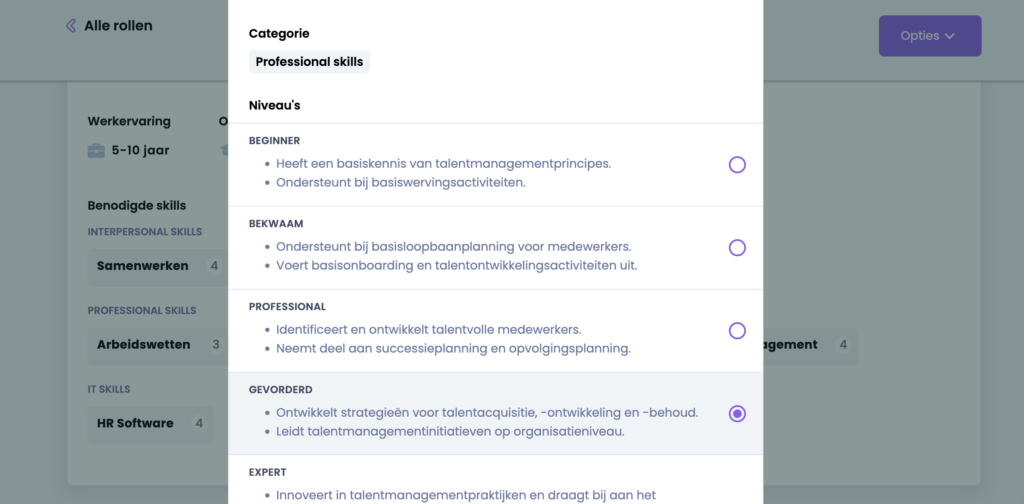A performance review, along with the appraisal review, is an important part of the HR interview cycle. But the traditional performance review has also come under a lot of fire. Fortunately, there is an alternative: a new-style performance appraisal.
We’ll explain exactly what a modern interview entails, including examples, and how it differs from an appraisal or evaluation interview.
💡 Wondering about an example already? View 10 questions to ask for a modern performance review
What is a new-style performance appraisal?
In a performance review, traditionally, as a supervisor, you discuss an employee’s performance over the past year or six months. Together you look back on someone’s performance and evaluate it. To make it a constructive and instructive conversation, it is important to keep the asking the right questions.Ideally, you will also provide an rating or score your team member’s performance. Yet it is not the idea that it is a one-sided conversation in which only the manager gives feedback. For this reason, the traditional performance or appraisal interview was sometimes criticized in the HR world in recent years: it was too often seen as a “judgmental conversation” in which mostly negative feedback was given.
But fortunately, you don’t have to do the performance review all the way through. abolish: the alternative is to make the call modernize.
The purpose of modern performance appraisals
The Modernizing your performance review goes beyond adding a self-assessment. The goal is to have an open conversation focused on development, contributing to the growth of an individual team member as well as the entire team.
You do that by incorporating these components:
1. FeedbackA modern performance appraisal is not just about (one-sided) judging performance, but also about giving and receiving feedback from both sides. That is why employees also give feedback to their manager and the team via the 360-degree feedback method. Daarnaast haal je volgens die methode feedback op bij collega’s, partners en anderen uit de organisatie, zodat je een breder perspectief verzamelt en het gesprek inhoudelijk sterker en waardevoller maakt.
2. Broad topics of conversation.Moreover, you discuss not only a person’s performance, in the form of measurable achievements and meeting goals, but also topics such as job happiness, professional growth and career opportunities. 3. Focused on developmentIn a performance review, you not only evaluate someone’s performance and each other, but also discuss development. At Learned, we actually always see a performance review as a combination of an evaluation and a development review. You discuss:
- goals for the upcoming period
- competencies or professional skills that a person can further develop, such as communication skills or knowledge of a software system
- other opportunities for growth and development, as well as obstacles
4. Continuous dialogueIdeally, you should not plan performance reviews just once a year, but make them part of an ongoing discussion cycle. Oftewel: van een ongoing dialogue in which you exchange feedback several times a year.
- 2 times a year a (formal) performance or evaluation interview
- A (informal) 1-on-1 conversation every month in which manager and employee check in with each other
- in each conversation you discuss skills, competencies and KPIs, but you also leave room for the broader conversation topics from point 2
Difference from a progress or assessment interview
The difference between a development interview, evaluation interview, performance interview and the progress interview can sometimes be subtle, as terminology may differ in different organizations and contexts.
In general, you can distinguish them this way:
Assessment interview
In a assessment interview evaluate a colleague’s performance and progress. Usually a supervisor provides feedback on actual results or targets that someone has achieved, and shares areas of improvement.
You also set new goals for the coming period in a typical appraisal interview.
The difference with a performance appraisal or evaluation interview is that an appraisal interview is more of a one-way street: traditionally, it does not include 360-degree feedback and ongoing dialogue.
Development Interview
The purpose of a development conversation is to create a plan to improve team members’ skills and abilities, and support their career development.
As the name makes clear, it is a conversation focused on professional development. Managers and employees discuss:
- strong points
- development needs
- career goals and advancement opportunities
- education or training needs
Performance or evaluation interview
During a performance appraisal, you evaluate someone’s overall performance. You usually do this over a period of time, such as a year or six months.
We use the terms performance and evaluation interview interchangeably; as synonyms for the same thing. Manager and employee look back on accomplishments achieved, and discuss future goals, KPIs or targets, skills someone wants to improve and what behaviors a team member can specifically improve for that purpose.
The goal is to give each other 360-degree feedback and based on that evaluation, discuss any rewards or development plans based on the assessment.
Looking for examples of a modern performance appraisal? Check out these 10 questions for an open, developmental evaluation conversation
Progress call
In a progress meeting, discuss the progress of projects, tasks or goals with a colleague.
It can take place regularly to check if the employee is on track, address any issues and make adjustments as needed. The goal is to monitor progress and ensure goals are met.
Tips for modernizing performance appraisals
Do you want to get started with the modernize your HR interview cycle, then it may be smart to begin with a new format for performance appraisals.
You do it like this:
1. Include feedback from the employee himself (and from colleagues)
One of the most significant changes is the addition of 360-degree feedback. This includes not only the opinion of the supervisor, but also that of colleagues and other stakeholders.
This provides a complete picture of your employees’ performance. This allows the manager to make a more informed and measured evaluation. Moreover, the input from other colleagues creates new insights for both the employee and the manager.
2. Expand the topics of conversation
Furthermore, you can expand the conversation with various topics of discussion.The difference with the traditional performance appraisal, is that in a modern conversation you not only assess someone’s performance or functioning, but also discuss other topics together.At Learned, we use 5 themes as guidelines for a modern, transparent performance appraisal :
- job satisfaction
- performance
- development
- learning objectives
- feedback about the organization
3. Make the conversation forward-looking
The discussion topics “development” and “learning goals” above make it clear: in a modern performance appraisal you not only evaluate past results, but also look ahead. A second development is the addition of questions focused on the future. That way, you make the conversation more actionable and more motivating for employees to work on their development: after all, you still have control over your behavior and performance in the future.
4. Evaluate objectively based on skills and competencies
If you can monitor the development and progress of employees over time, it is important to keep returning to the same discussion topics in performance appraisals. Then, if you also want to focus on evaluating as objectively as possible, measure someone’s development using:
- competencies (or soft skills)
- hard skills (or technical skills)
These are the same competencies and skills found in the skills-based job profile because by evaluating on them you create a clear picture of what is expected in a particular job (level) – for both employees and their managers.
Bonus tip 💡 Performance reviews 2.0 are often not the only conversation between managers and employees, but part of multiple conversations – including informal ones – in an ongoing HR interview cycle.
How do you measure the outcome of a performance review?
You can choose to measure a performance appraisal purely qualitatively.But if your goal is to make evaluations objectively measurable, you can also assign a score to each of the points you evaluate in the conversation.There are 3 steps you can take to make evaluations objectively measurable:
Step 1. Score mastery of skills and competencies
In a modern performance appraisal, you also discuss someone’s development – in the form of their mastery of the skills and competencies needed in a position (see point 4 above).
The mastery of skills or competencies is measured by various levels.
And you can easily express your feedback on someone’s skill or competency level in a score, for example qualitatively (insufficient, moderate, adequate, good, very good) or with a grade (from 0-5).
That way, at the end of the conversation, you can have a total rating give – which allows you to clearly see how an employee is performing against the goals and requirements of their job profile.
Tip 💡 To make your evaluation of skills and competencies as objective as possible, it helps to work with a system in which the levels are written out in concrete behavior.
Step 2. Keep score over multiple calls
By keeping score across multiple interviews, you get a clear picture of employee development over time.
For example, performance appraisals offer not only qualitative feedback, but also many quantitative insights that you can evaluate at the end of the year.
Step 3. Use data from evaluations to inform action
Once you hang a measurable score on the points you discuss in performance appraisals, you collect a lot of data that you can use very well in HR. The most important action to take based on the data from evaluations is to use the measurements of someone’s performance and development as the rationale for a fair compensation.In addition, you can use data from performance appraisals for:
- comparing performance of different team members, e.g., in a 9-grid
- determining development plans
- decisions on promotions and internal advancement
- designating future executives: succession planning
Want to know more? Read more about the benefits of objective evaluation
Sample form
Want to get started right away on modernizing the performance appraisal interview? Then download our template with 20+ sample questions for conducting a motivational interview focused on development.
💪 Start having valuable and forward-looking performance reviews too! Download here our template for a modern performance appraisal






























